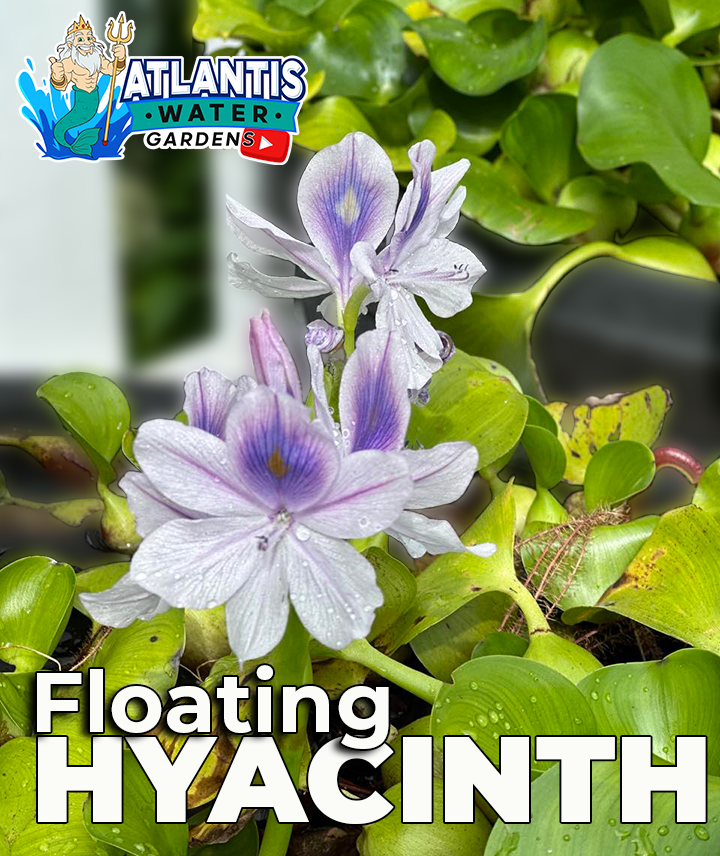
How can I get water hyacinth benefits in New Jersey ponds?
Looking for a low-maintenance way to boost your pond’s health, clarity, and style? 🌿 Water hyacinths are your new favorite floating plant. These vibrant bloomers do way more than look good—they filter water, fight algae, and support a thriving pond ecosystem.
Let’s break down the biggest water hyacinth benefits New Jersey pond owners love 👇
1. Natural water filtration 🧽💧
Water hyacinths soak up nutrients like nitrogen and phosphorus—the exact stuff that algae feeds on. Their fluffy root systems also trap floating debris, leaving your pond clearer and healthier without chemicals.
It’s like a built-in, living pond filter. 🙌
2. Shade + shelter for fish 🐠🌿
Fish aren’t just surviving—they’re thriving with hyacinths in the water. The large leaves offer shade on sunny days, while the hanging roots create a safe place for koi, goldfish, and even baby fish to hide and rest.
Less stress = healthier, more active fish.
3. Say goodbye to algae blooms 🌞🚫
Too much sunlight leads to aggressive algae growth. Hyacinths float across the surface and block out light, reducing algae naturally. It’s one of the top water hyacinth benefits New Jersey pond owners rely on.
Fewer algae blooms means more time enjoying your pond—not cleaning it.
4. Gorgeous summer blooms 💜🌸
Let’s be real—these things are pretty. In summer, water hyacinths produce delicate lavender blooms that rise just above the leaves. Even when not flowering, the lush green foliage adds texture and tropical vibes to any setup.
Big visual impact with zero digging required.
5. Easy-care all season long 🪴😎
Water hyacinths basically take care of themselves. Just float them in your pond and trim back when they spread too much. No soil, no planting, no stress.
Before the first frost hits, simply remove them—they don’t overwinter in New Jersey.
6. A stronger, healthier pond ecosystem 🌍💧
Cleaner water, less algae, and happy fish all contribute to a balanced, low-maintenance pond. If you’re aiming for a natural system that looks amazing and runs smoothly, hyacinths are a no-brainer.
These floating plants really do it all.
🌿 Bonus Tip: Use them strategically!
Place water hyacinths near waterfall edges or spillways—they’ll get the water movement they love while creating a soft, natural look. Want more control? Use floating plant rings to keep them from clustering.
💬 FAQ: Water Hyacinths & New Jersey Ponds
Are water hyacinths safe for backyard ponds?
Yes—but they grow fast. Keep them contained and trimmed. Fish Pond Builders Essex County often recommend floating baskets to manage spread.
Do water hyacinths help reduce algae?
Absolutely. They block light and absorb nutrients algae needs to grow. Koi Pond Maintenance Morris County uses them all summer for natural algae control.
Can I use water hyacinths in a koi pond?
Definitely. Koi love the shade and cover, though some might nibble roots. Pond Fountain Installers Short Hills suggest combining them with rooted marginals.
Do I have to remove water hyacinths in winter?
Yes—they’re tropical and won’t survive frost. Fish Pond Installers Millburn recommend removing and composting them before first freeze.
How many hyacinths should I start with?
1–2 per square foot of pond surface is a good starting point. Garden Pond Builders Near Me recommend thinning weekly once summer hits.
💧 Ready to Experience the Water Hyacinth Benefits New Jersey Pond Owners Love?
Cleaner water, fewer algae problems, blooming plants, and healthier fish? Water hyacinths check every box—and we’re here to help you use them right.
📞 Call us at 973-627-0515 for expert help with pond plants, maintenance, or full pond setups. Let’s make your pond the best part of your backyard.
Unable to make it into our retail location? Check out our NEW ONLINE STORE!
Be sure to check our our Learning Hub for many more great blogs, videos and inspiration! New Jersey Waterfall Installation Done in Just 1 Day? You better believe it! 5 Reasons a Full Water Change in Spring Could Harm Your Pond